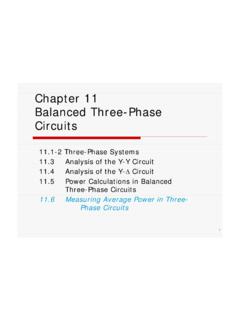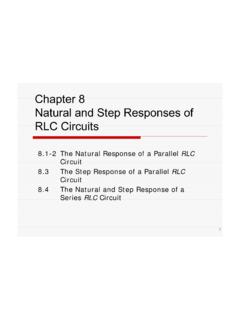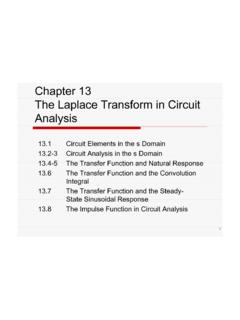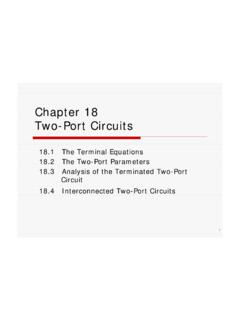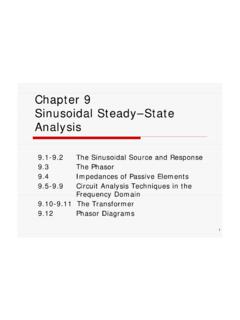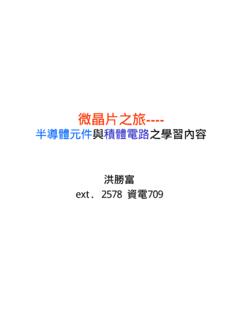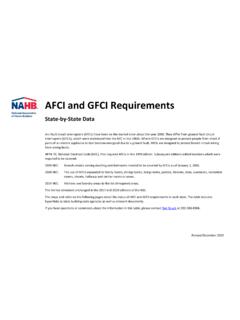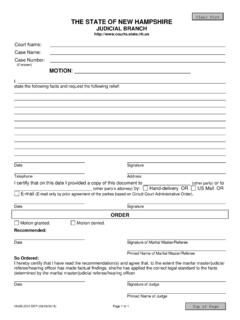Transcription of Chapter 7 Response of First-order RL and RC Circuits
1 1 Chapter 7 Response of First-order RL and RC Circuits The Natural Response of RL and RC The Step Response of RL and RC A General Solution for Step and Natural Sequential Unbounded Response2 Overview Ch9-10 discuss steady-state Response of linear Circuits to sinusoidal sources . The math treatment is the same as the dc Response except for introducing phasors and impedances in the algebraic equations. From now on, we will discuss transient Response of linear Circuits to step sources (Ch7-8) and general time-varying sources (Ch12-13). The math treatment involves with differential equations and Laplace circuit A circuit that can be simplified to a Th venin (or Norton) equivalent connected to either a single equivalent inductor or capacitor. In Ch7, the source is either none (natural Response ) or step points Why an RC or RL circuit is charged or discharged as an exponential function of time?
2 Why the charging and discharging speed of an RC or RL circuit is determined by RC or L/R? What could happen when an energy-storing element (C or L) is connected to a circuit with dependent source? 5 Section , The Natural Response of RL and RC Circuits1. Differential equation & solution of a discharging RL circuit2. Time constant3. Discharging RC circuit6 What is natural Response ? It describes the discharging of inductors or capacitors via a circuit of no dependent source. No external source is involved, thus termed as natural Response . The effect will vanish as t . The interval within which the natural Response matters depends on the element model of a discharging RL circuit Consider the following circuit model: For t < 0, the inductor L is short and carries a current Is , while R0 and R carry no current.
3 For t > 0, the inductor current decreases and the energy is dissipated via differential equation (ODE), initial condition (IC) For t > 0, the circuit reduces to: By KVL, we got a First-order ODE for i(t):where L, R are independent of both i, and 0)0()0(.0)()( tRitidtdLIC depends on initial energy of the inductor:9 Solving the loop currentRL ;)0(:IC ,0)()( :ODE0sIIitRitidtdL ,)(ln)0(ln)(ln,ln ,, ,0)()(00)()0(0)()0(tLRItiititLRitdLRiidd tLRididtRidiLttiittii teIti 0)( , where ..time constant10 Time constant describes the discharging speed The loop current i(t) will drop to e-1 ( 37%) of its initial value I0 within one time constant . It will be < after elapsing 5 . If i(t) is approximated by a linear function, it will vanish in one time of the voltage, power, and energy .0for ,,0for ,0)()(0teRIttRitvt.
4 Abrupt change at t =0. The voltage across R (or L) is: .0for ,)()(2202 teRIRtitp t The instantaneous power dissipated in R is: .0for ,2 ,1)(200200220 0 tLIwewtdeRItdtpw tt tt The energy dissipated in the resistor R is:initial energy stored in L12 Example : Discharge of parallel inductors (1) Q: Find i1 (t), i2 (t), i3 (t), and the energies w1 , w2 stored in L1 , L2 in steady state (t ). For t <0: (1) L1 , L2 are short, and (2) no current flows through any of the 4 resistors, .J 1602)4)(20()0(,J 1602A) 8H)( 5()0(,0)0( ,A 4)0( ,A 8)0(2221321 wwiii13 Example : Solving the equivalent RL circuit (2) For t >0, switch is open, the initial energy stored in the 2 inductors is dissipated via the 4 equivalent circuit becomes: The solutions to i(t), v(t) are:Leq = (5H//20H) = 4 HI0 = (8+4) = 12 Av(0-) =0 V. 96)()(,A 12)( ,s Req = 8 14 Example : Solving the inductor currents (3)V 962te A.
5 (1)0()(2020111ttttetdetdtvLiti A. )(1)0()(2020222ttttetdetdtvLiti The two inductor currents i1 (t), i2 (t) can be calculated by v(t):15 Example : Solutions in steady state (4) Since The energies stored in the two inductors are:J, ) )(20(21)(J, )A )(H 5(21)(2221 twtwwhich is ~10% of the initial energy in , )(A, )(2221 ttetietithe two inductors form a closed current loop!16 Example : Solving the resistor current (5) By current division, i3 (t) = (t), while i4 (t) can be calculated by v(t):i4 A. )10//15(4)()(224tteetvti A. )(53)(243tetiti 17 circuit model of a discharging RC circuit Consider the following circuit model: For t <0, C is open and biased by a voltage Vg , while R1 and R carry no current. For t >0, the capacitor voltage decreases and the energy is dissipated via & )()( RtvtvdtdCgVVvv 0)0()0( By KCL, we got a First-order ODE for v(t):where C, R are independent of both v, and t.)
6 For t >0, the circuit reduces to:IC depends on initial energy of the capacitor:19 , where ..time constantSolving the parallel voltage;)0(:IC ,0)()( :ODE0gVVvRtvtvdtdC RC teVtv 0)( Reducing R (loss) and parasitic C is critical for high- speed of the current, power, and energy .0for ,,0for ,0)()(0teRVtRtvtit ..abrupt change at t =0. The loop current is: .0for ,)()(2202 teRVRtvtp t The instantaneous power dissipated in R is: .0for ,2 ,1)(20020 0 tCVwewtdtpw tt The energy dissipated in the resistor R is:initial energy stored in C21 Procedures to get natural Response of RL, RC circuits1. Find the equivalent Find the initial conditions: initial current I0 through the equivalent inductor, or initial voltage V0 across the equivalent Find the time constant of the circuit by the values of the equivalent R, L, C:4.
7 Directly write down the solutions:;or ,RCRL .)( ,)(00 tteVtveIti 22 Section The Step Response of RL and RC Circuits1. Charging an RC circuit2. Charging an RL circuit23 What is step Response ? The Response of a circuit to the sudden application of a constant voltage or current source, describing the charging behavior of the circuit . Step (charging) Response and natural (discharging) Response show how the signal in a digital circuit switches between Low and High with and IC of a charging RC circuit ,1 ),()(fsVvdtdvtvdtdCRtvI Derive the governing ODE by KCL:0)0()0(Vvv where are the time constant and final (steady-state) parallel depends on initial energy of the capacitor:RIVRCsf , 25 Solving the parallel voltage, branch currents .)(0 tffeVVVtv .0for ,)()( ,)()(0 tRtvtieRVItvdtdCtiRtsC ,)(,)(ln,1,1,1000)(0 tffffttvVsffeVVVtvtVVVtvtdRIvvddtVvdvVvd tdv The charging and discharging processes have the same speed (same time constant =RC).
8 The branch currents through C and R are:26 Example (1) For t <0, the switch is connected to Terminal 1 for long, the capacitor is an open circuit : Q: Find vo (t), io (t) for t )0( ,V 30k 60)20(k 60V) 40()0( ooiv27 Example (2) At t 0+, the charging circuit with two terminals 2 and G can be reduced to a Norton equivalent: +v0V 30)0()0(0 VvvooGmA sI28 Example (3) The time constant and the final capacitor voltage of the charging circuit are: .V 9060)(1000ttffoeeVVVtv .mA )(1000ttsoeeRVIti ,ms 10)F )(k 40( 60)k 40)(mA ( RIVsf At the time of switching, the capacitor voltage is continuous: , while the current io jumps from 0 to )9060()0(V 30)0(0 vvo29 Charging an RL circuit ,)( ),()(0 tffseIIItitidtdLtRiV 0)0()0(Iii IC depends on initial energy of the inductor:where.
9 ,RVIRLsf The charging and discharging processes have the same speed (same time constant =L/R).30 Section Sequential Switching31 What is and how to solve sequential switching? Sequential switching means switching occurs n ( 2) times. It is analyzed by dividing the process into n+1 time intervals. Each of them corresponds to a specific circuit . Initial conditions of a particular interval are determined from the solution of the preceding interval. Inductive currents and capacitive voltages are particularly important for they cannot change abruptly. Laplace transform (Ch12) can solve it : Charging and discharging a capacitor (1)t =0t =15 ms Q: v (t)=?for t )0(0 vVIC: For 0 t 15 ms, the 400-V source charges the capacitor via the 100-k resistor, Vf = 400 V, = RC =10 ms, and the capacitor voltage is:V.
10 400400)()(10001ttffeeVVVtv 33 Example (2) For t >15 ms, the capacitor is disconnected from the 400-V source and is discharged via the 50- k resistor, V0 = v1 (15 ms) = V, Vf = 0, = RC = 5 ms. The capacitor voltage is:V. )() (200)(020 ttteeVtv 34 Section Unbounded Response35 Definition and reason of unbounded Response An unbounded Response means the voltages or currents increase with time without limit. It occurs when the Th venin resistance is negative (RTh <0), which is possible when the First-order circuit contains dependent sources. 36 Example : (1) Q: vo (t)=?for t 0. For t >0, the capacitor seems to discharge (not really, to be discussed) via a circuit with a current-controlled current source, which can be represented by a Th venin -5,k 207k 20k 10 TTThTTTTivRvvviExample (2) Since there is no independent source, VTh =0, while RTh can be determined by the test source method:38 Example (3) For t 0, the equivalent circuit and governing differential equation become.
